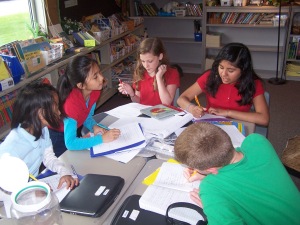Teaching Teamwork
Some students in your class have been on a baseball team, basketball team, soccer team, Boy Scout troop, computer club, and church group.
Most, however, have not.
Teamwork skills in schools have never been more important. We have, rightfully so, developed collaborative activities requiring students to compromise and work together toward the same goal. The working world will require our students to be productive team members, and we want our students to be successful. Because we know this, teachers from kindergarten to high school have students working together.
Teamwork can be challenging. It would be nice if every student entered our room knowing how to function in a team, but we know they don’t. As teachers we have two options: 1. Just keep doing more group activities and hope it gets better. 2. Explicitly teach the students how to work together. Teaching is far superior to hoping.
I have found five “teamwork agreements” help facilitate the behaviors I’m looking for in group members. I start teaching these during the first week of school, and they still make an appearance here in May whenever we see an activity involving collaboration on the day’s agenda.
1. Use a kind tone of voice. – I demonstrate how a sentence like “I think we should do this” can either sound helpful or snobbish depending on the way it is said. I want the students talking. This helps them know how.
2. Be open to others’ ideas. – Students need to know that the first idea is not always the best. Talking about how I work with my grade level team helps them see how this works.
3. Take turns. – Yes, no matter how old your students are, this should be on your list.
4. Stay with your group at all times. – This is a must for management. For groups to function, all members must be there; nobody can be hanging out on the other side of the classroom. If appropriate, you can add the requirement that students are only conversing with their own group as well.
5. No hogs! No logs! – I came across this in a blog post a long time ago, and it’s gold. “Hogs” control the group, limit others’ potential, and do the entire assignment themselves. This won’t work. “Logs” sit back and do nothing while everyone else does the work. Likewise, this won’t work either. Just labeling these classic types of nonproductive group members makes students less likely to fall into these roles. They’ll even catch each other. I often hear them says, “Remember, no hogs and no logs,” as I walk around.
Teaching these agreements during the first month of school is key, but students will need to review them throughout the year. Hopefully you can use these ideas to guide your students to become productive team members.
Posted on May 11, 2015, in Uncategorized. Bookmark the permalink. Leave a comment.

Leave a comment
Comments 0